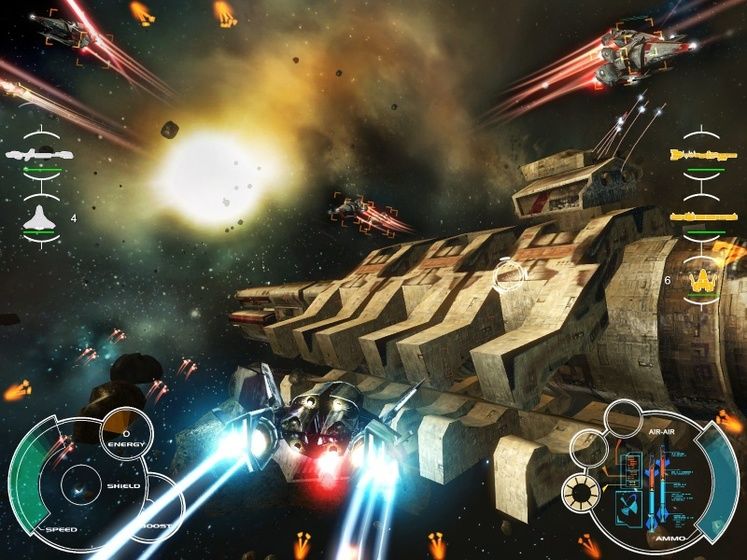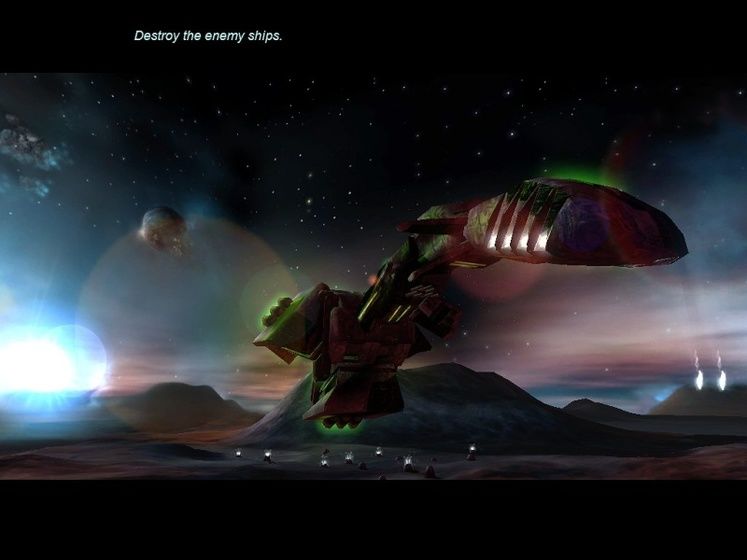For a game with a rather lame name, Space Interceptor: Project Freedom isn’t too bad at all, especially for a budget game. Although lacking the sky-high production values of recent high-profile releases, this game provides an exciting arcade experience that should keep you entertained for the entirety of its five hour campaign. With the lack of decent (or any) space shooters as of late, this game is a welcome surprise.
When you start the game, you will be greeted by an intro that seems like it would better serve as a trailer for the game. While most games tend to keep you engrossed in the experience by presenting the story through a somewhat third person perspective, this game addresses you directly in the second person. This would be OK, if the game stayed consistent. Halfway through the game, the character you are playing will actually speak, and you’ll feel oddly disconnected to see a person speaking that should technically be yourself. Other than that, the story is standard sci-fi fare.It is largely expressed through decent pre-rendered cutscenes and the occasional radio chatter from your wingmen.
The graphics in the game are impressive for a budget title. When you’re flying out in space, you’ll see distant planets and asteroids, which are all nicely rendered. When you’re flying above the surface of a planet, you’ll be treated to decently rendered landscapes and other land scenery. Special effects such as explosions look good, but not spectacular. Unfortunately, your first person view mode has a heads-up-display that literally takes up a third of your screen. You do have the ability to switch to third person view mode, but as any half-serious space sim fan will tell you, first person view mode is the only way to go. The disappointing part is that only a small part of the heads-up-display even serves a purpose; the rest of it is just eye candy.
The sound in the game is what you would expect from a budget title. The sound effects correspond well to what you’re doing. The explosions sound decent, and the weapons all sound as you would expect. However, the music is selection is barren, at best. There are only a select few techno loops that’ll play in the background. There are 21 levels in the campaign, and only a handful of tracks that loop a 12 second melody. Admittedly, the music doesn’t sound too bad and fits well with the high-paced action, but the problem is just that there isn’t enough of it. There is some voice acting in the game, and although the writing is pretty bad, most of the actors read their lines decently. However, there simply isn’t enough of it. The developers for one reason or another decided that every shot needs a comment. What this means is that you’ll be hearing “right between the eyes” and “nice kill” at least 20 times per mission, which gets annoying quickly.
The gameplay is where the game truly shines. Although mostly straightforward, the action is fast-paced and satisfying. The controls for your ship are amazingly simple and yet effective. The default setup has you controlling your ship with the mouse, which works amazingly well. You have the left mouse button to fire lasers, and your right mouse button to launch special secondary weapons. Then, you have a button on the keyboard to cycle through available secondary weapons and you’re all set. This kind of streamlined control system adds to the fun and playability factor of Space Interceptor: Project Freedom.
Going with the playability factor, you’ll have the option to advance the status of your ship as the 21 mission campaign unfolds. This process is extremely simple, and requires little of your attention. All you do is pick one of three categories before a mission; attack, defense, and speed. After the end of the mission, that specific category will be upgraded automatically. Thus, your ship will improve with little trouble on your part. Some people may be put off by such a simple system, but for the rabid action junky, this is just perfect as it lets them get back into the action faster.
As is par with games of this type, the AI in the game is pretty much useless. Your wingmen don’t seem to serve any purpose other than to comment on your shooting. It’s kind of annoying that the game bothers to point out exactly how many allies you have per mission, since these allies rarely hit anything. The game somehow thinks that adding to the number of allies will make the missions any easier. The enemy AI isn’t much better, but they sure do put up a fight in sheer numbers. This is to be expected for games of this type, though.
The actual missions will range from protecting ally ships to destroying ground facilities to just simple shoot-em-up missions. Whichever type you play, the gameplay is always fun and fast-paced. You’ll never have more than a few seconds of downtime, especially thanks to the very quick load times. Unfortunately, this leads to the game’s own downfall. As is par with fast-paced, high-action games, it’s very short. A mere 5 hours after booting up the game; you will have completed the campaign.
This wouldn’t be a problem if there was some kind of multiplayer, or something else to keep you occupied. Since the upgrade system in the game is simple (you could get all the upgrades on your first way through), there is virtually no reason to play the campaign again. There are different difficulty settings, so that may give you a reason to play the fun-filled missions again. Unfortunately, the differences between the difficulty levels are not very significant. The lack of multiplayer is a big disappointment, as this game would be simply superb as a multiplayer experience.
SPACE INTERCEPTOR: PROJECT FREEDOM VERDICT
Space Interceptor: Project Freedom is a fun little game while it lasts. If you’re a fan of the space shooter genre, you will undoubtedly like this game. It’s just a shame that it doesn’t last longer. If you don’t mind shelling out 20 bucks for a 5 hour joyride, pick this one up. Those looking for a game that will last you for months to come, look elsewhere.








